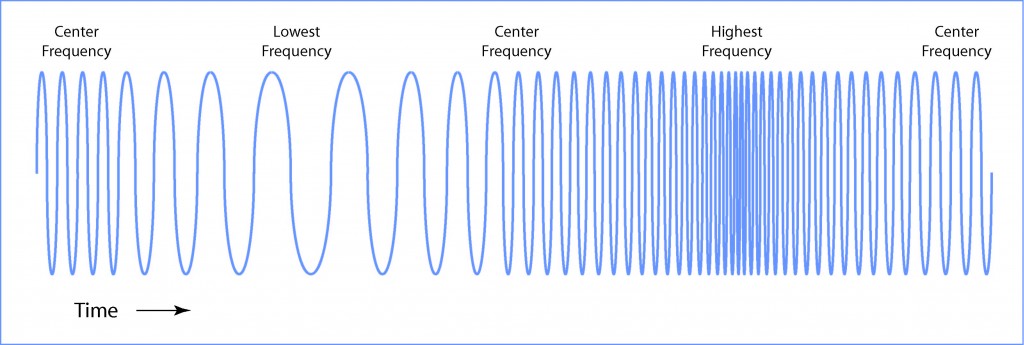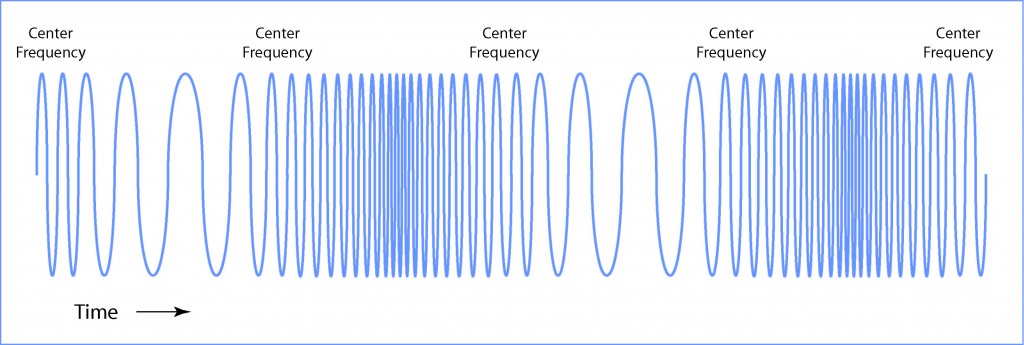In today’s blog we once again bring ultrasonic sounds into the range of human audibility and listen to the sound of frequency sweep. Previous blogs have revealed the sound of amplitude modulation and pulse modulation. Frequency sweep is all about frequency – ideally there is no change in amplitude as frequency is varied. In some of the following sound clips you might think there is a change in amplitude as frequency varies. This is a sort of an audio illusion. The human ear perceives sounds at different frequencies with varying sensitivity. Lower frequency sounds are generally perceived to have lower amplitude than higher frequency sounds. There also may be variations in the ability of whatever device you are using to listen to these sounds to reproduce them. No amplifier/speaker combination is completely linear in its ability to reproduce sounds at different frequencies. Laptop computers are notorious for poor sound reproduction so I might recommend that you take this opportunity to grab your headphones before listening to the sound clips. Varying Frequency – In this example only the frequency of the sound will change. The sound starts at a frequency. Then the frequency is reduced. After the lowest frequency is reached, the frequency is increased passing through the starting frequency and on to the highest frequency in the sweep and then back to the starting frequency. The starting, intermediate and ending frequency is commonly known as the “center” frequency of the sweep. The X-Y plot looks like this –  And sounds like this – –
And sounds like this – –
Range or Deviation – Increasing the range of sweep decreases the lowest frequency and increases the highest frequency. The starting, intermediate and ending frequencies remain the same. The X-Y comparison of increased sweep range compared to the plot above looks like this –  In the following sound clip, the sweep range starts at zero or no deviation. This is a steady tone also known as the center frequency. As the clip progresses, the deviation of the sweep is increased to a maximum and then reduced again to zero. It sounds like this – –
In the following sound clip, the sweep range starts at zero or no deviation. This is a steady tone also known as the center frequency. As the clip progresses, the deviation of the sweep is increased to a maximum and then reduced again to zero. It sounds like this – –
Varying Frequency Deviation or Range
Sweep Frequency – The rate at which the frequency is varied is the “sweep frequency.” The following X-Y plot shows a sweep frequency double that of the first illustration above.  In the following sound clip, the frequency sweep range remains constant but the frequency sweep rate starts at a relatively low frequency, increases to a high frequency and then returns to the starting, low frequency – –
In the following sound clip, the frequency sweep range remains constant but the frequency sweep rate starts at a relatively low frequency, increases to a high frequency and then returns to the starting, low frequency – –
Combining the variables of amplitude, pulse and frequency allow a great deal of flexibility in ultrasonic cleaning. Proper selection of these parameters can improve the ultrasonic cleaning effect while reducing the possibility of part damage. Upcoming blogs will explain in more detail how to select the correct combination for a particular application.
Oh, and by the way, I will not be responsible if you decide to insert that last sound clip into the startup folder of your computer (or someone else’s?).
– FJF –



 English
English Spanish
Spanish Chinese
Chinese Canada
Canada Mexico
Mexico United Kingdom
United Kingdom



